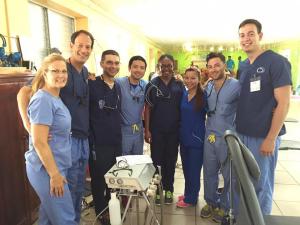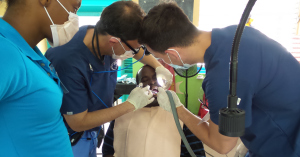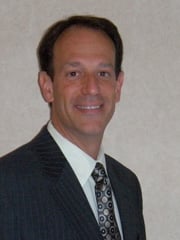Dentistry Abroad: Providing Oral Healthcare in St. Lucia
As doctors, we have committed to improving the lives of our patients. While we all do this on a daily basis in our local communities, providing oral healthcare to patients without the necessary dental resources can be an eye-opening—and life-changing—experience.
 This summer, I was asked by Great Shapes!, a non-profit program that facilitates humanitarian aid in the Caribbean, to participate in its 1000 Smiles Dental Project in St. Lucia. This trip also included the director of endodontics and three endodontic residents from the University of North Carolina as well as a pediatric dentist. I was also fortunate to have my wife Katie, an emergency room RN, and my youngest son Zach, a sophomore at Penn state, join me as volunteers during the week.
This summer, I was asked by Great Shapes!, a non-profit program that facilitates humanitarian aid in the Caribbean, to participate in its 1000 Smiles Dental Project in St. Lucia. This trip also included the director of endodontics and three endodontic residents from the University of North Carolina as well as a pediatric dentist. I was also fortunate to have my wife Katie, an emergency room RN, and my youngest son Zach, a sophomore at Penn state, join me as volunteers during the week.
Preparing to Work Abroad
There are a number of behind-the-scenes tasks that must be completed before leaving the country. First, I applied for a temporary dental license from the government of St. Lucia that allowed me to practice dentistry while on the island.
Ensuring you have the right supplies is crucial. My local Rotary Club lent me a great deal of support by donating supplies for the trip. Additionally, I brought much of my own equipment to ensure I was able to properly diagnose and treat patients. It’s important to note here that there are also dental technology companies that will loan small, portable equipment to organizations who perform mission work.
Working in St. Lucia
There are approximately 180,000 people living in St. Lucia and only 18-20 active dentists. Most of the patients that we saw had never had dental work done. Besides the lack of access to care, cost also plays a role in poor oral hygiene. Most people wait until the pain is unbearable before seeking dental care; because of this, much of our daily work involved extractions. For example, we extracted the first molars from children, as they’re the first to come in and the first to decay without good brushing. Fortunately, St. Lucia has recently started a sealant program that will improve future cases like these. We also extracted adult teeth that could have been saved with better oral hygiene.
 In between treating patients and supervising the UNC residents, I was also able to work with dental nurses who were providing oral hygiene instruction to the people waiting in line for care. Good oral hygiene habits play a key role in preventing future dental issues. My hope is that by laying this groundwork now, fewer extractions will be necessary during my next trip.
In between treating patients and supervising the UNC residents, I was also able to work with dental nurses who were providing oral hygiene instruction to the people waiting in line for care. Good oral hygiene habits play a key role in preventing future dental issues. My hope is that by laying this groundwork now, fewer extractions will be necessary during my next trip.
The Importance of Continuing Education
As a dentist, especially a specialist, continuing education courses are crucial—yet few lecturers visit St. Lucia. Thankfully, the two other doctors and I were able to speak to a room of about 20 dentists, which was essentially every dentist on the island. The local doctors were interested in dental technology advancements in the U.S. and I was happy to share with them about cone beam computed tomography (CBCT), which I use in my own practice for placing implants and checking wisdom teeth, among other things. This discussion also led to CAD/CAM and digital intraoral scanning, which is beginning to play a part when placing implants.
Helping patients in under-served communities is a rewarding experience on many levels. Through my work in St. Lucia, I gained an appreciation for all of the dental services we offer in the States and felt gratitude for being able to help others through my work.






